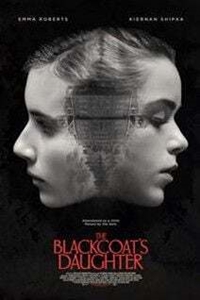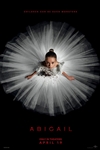The Blackcoat's Daughter (February) (R) ★★★
 The best thing to be said about The Blackcoat's Daughter is that it's unconventional. The worst thing is that, for a horror film, it's neither scary nor creepy. Writer/director Osgood (Oz) Perkins (the son of Psycho star Anthony Perkins), making his directorial debut, opts for a slow-burn approach and, while that emphasizes atmosphere, it engenders a certain degree of impatience. The narrative's elliptical approach demands attention. The movie is a puzzle whose picture doesn't snap into focus until the final piece is in place. Even then, The Blackcoat's Daughter may require a second viewing for the fuzziness to dissipate. There are times when the movie feels stilted; characters are half-formed and not entirely believable. That is at least in part due to the filmmakers' decisions about structure and, in hindsight, they may be the right choices.
The best thing to be said about The Blackcoat's Daughter is that it's unconventional. The worst thing is that, for a horror film, it's neither scary nor creepy. Writer/director Osgood (Oz) Perkins (the son of Psycho star Anthony Perkins), making his directorial debut, opts for a slow-burn approach and, while that emphasizes atmosphere, it engenders a certain degree of impatience. The narrative's elliptical approach demands attention. The movie is a puzzle whose picture doesn't snap into focus until the final piece is in place. Even then, The Blackcoat's Daughter may require a second viewing for the fuzziness to dissipate. There are times when the movie feels stilted; characters are half-formed and not entirely believable. That is at least in part due to the filmmakers' decisions about structure and, in hindsight, they may be the right choices.
This may be one of those instances when a film's on-demand streaming accessibility is an asset because watching The Blackcoat's Daughter a second time is a more rewarding experience than the first time through. Although it's true that the surprises will have been spoiled by the first viewing, those things are ultimately secondarily to the story Perkins is telling. Once the viewer understands how the three primary characters relate to one another, it's easier to follow their evolution.
The Blackcoat's Daughter opens in familiar territory for a horror/exploitation film. It's February at Bramford Academy, an all-girls Catholic boarding school in upstate New York. Two girls, worldly Rose (Lucy Boynton) and quiet Kat (Kiernan Shipka), are alone during a week-long break, their parents having failed to pick them up. The place is inhospitable with so few people around. Although Rose is told by the headmaster to "look after" Kat, the older girl has problems of her own - she suspects she's pregnant and has to inform her boyfriend and make arrangements for an abortion. Kat, meanwhile, has been experiencing unsettling dreams that predict her parents' deaths.
A second, seemingly-unrelated story follows Joan (Emma Roberts), a mental institution escapee who is loitering at a bus stop when she encounters Bill (James Remar). Noticing that she is ill-dressed for the cold weather, he offers her a ride in his car. He and his wife, Linda (Lauren Holly), are traveling to nearby Bramford and can take her there, where she can find shelter. It soon becomes apparent that Joan is not who she pretends to be and her connection to Rose and Kat emerges during the film's third and final act.
Although The Blackcoat's Daughter lacks traditional scares, it comes complete with some big shocks. These aren't the garden-variety jump-scares that have come to infiltrate horror films; instead, they're narrative-based, indicating that viewers shouldn't become too comfortable with the direction in which they think the story is going. It all makes sense in the end but, as events are unfolding, things can seem haphazard. Although the plots are completely dissimilar, I was reminded of aspects of Pulp Fiction's structure in the way this movie unfolds.
The cast is populated by capable but low-wattage stars. The biggest name is perhaps Emma Roberts although, despite entering the profession with some fanfare (perhaps due to her relationships to Eric and Julia Roberts), she has gravitated toward more obscure roles. This may not be one of her better-known roles, but it represents one of her better acting performances. She is joined by Lucy Boynton, perhaps best known for Sing Street, and Kiernan Shipka, who is recognizable from a recurring role on the TV series "Mad Men." Support comes from James Remar and Lauren Holly, who are rarely seen outside of a car during the course of the film.
The film's writer/director, Oz Perkins, technically made his feature debut with The Blackcoat's Daughter, although the movie was released after Perkin's second film, I Am the Pretty Thing that Lives in the House. Perkins entered the industry as an actor, appearing as a young Norman Bates in Psycho II. After that, he took only roles in front of the camera (and sparingly, at least at first) for the next 30 years. His work here is assured, making it surprising that he has done so few projects in the last eight years (although the pandemic may have had something to do with that). The Blackcoat's Daughter doesn't look like a first film. Some genre fans may feel cheated by the lack of overt gore (there is some but, although it's explicit enough to have warranted an R-rating, it falls considerably short of the graphic bloodletting of slasher films), the unhurried pace, and the lack of many horror tropes, but the movie isn't a carbon copy of every other "demon possession" movie out there.
© 2023 James Berardinelli
To get the full Quicklook Films experience, uncheck "Enable on this Site" from Adblock Plus
box office top 10

Civil War Released: April 12, 2024 Cast: Kirsten Dunst, Wagner Moura 11.1M

Abigail Released: April 19, 2024 Cast: Melissa Barrera, Dan Stevens 10.2M

Godzilla x Kong: The New Empire Released: March 29, 2024 Cast: Rebecca Hall, Brian Tyree Henry 9.5M

The Ministry of Ungentlemanly Warfare Released: April 19, 2024 Cast: Henry Cavill, Eiza Gonzalez 9M

Spy x Family Code: White Released: April 19, 2024 Cast: Takuya Eguchi, Saori Hayami 4.9M

Kung Fu Panda 4 Released: March 8, 2024 Cast: Jack Black, Viola Davis 4.6M

Ghostbusters: Frozen Empire Released: March 22, 2024 Cast: Paul Rudd, Carrie Coon 4.4M

Dune: Part Two Released: March 1, 2024 Cast: Timothée Chalamet, Rebecca Ferguson 2.9M

Monkey Man Released: April 5, 2024 Cast: Dev Patel, Sikandar Kher 2.2M

The First Omen Released: April 5, 2024 Cast: Nell Tiger Free, Bill Nighy 1.7M






